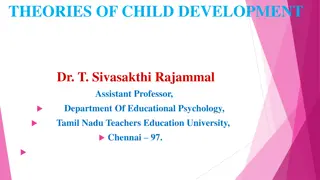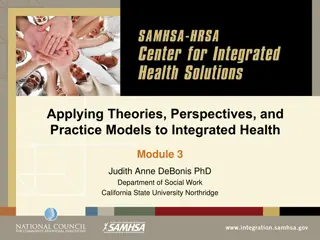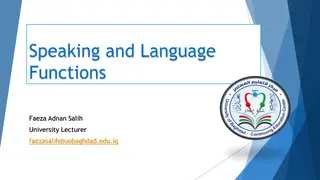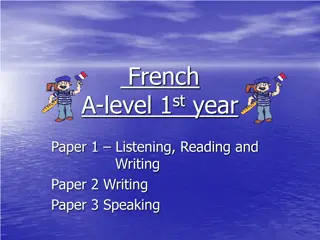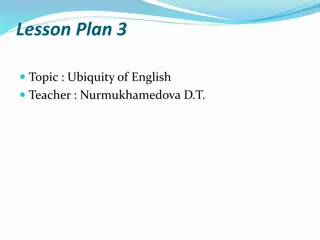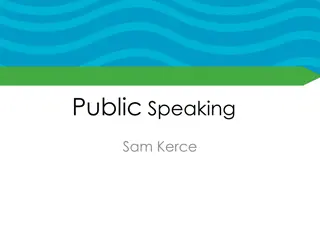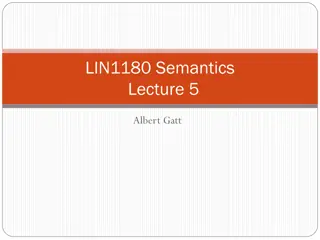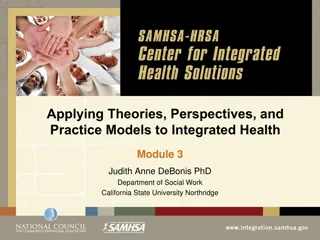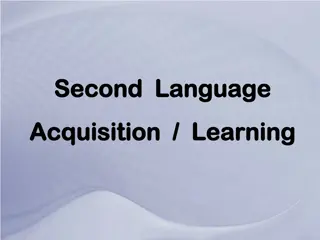Theories of Child Language Acquisition and Speaking Challenges
Children learn to speak through various theories including behaviourism, social interactionism, innatism, and cognitivism. Language acquisition involves imitation, interaction with caretakers, innate language capacity, and cognitive development stages. Learning to speak is considered a complex intellectual feat requiring mastery of sounds, words, meanings, and grammar. Each theory offers unique perspectives on how children acquire language skills.
- Child language acquisition
- Speaking development
- Language learning theories
- Challenges in speaking
- Cognitive development
Download Presentation

Please find below an Image/Link to download the presentation.
The content on the website is provided AS IS for your information and personal use only. It may not be sold, licensed, or shared on other websites without obtaining consent from the author. Download presentation by click this link. If you encounter any issues during the download, it is possible that the publisher has removed the file from their server.
E N D
Presentation Transcript
English Language Child Language Acquisition
How do children learn to speak? The four main theories: Children learn language through imitation (Behaviourism). Children learn language through a specific type of interaction with their caretakers (CDS). Children have an innate capacity for language (Innatism). Children develop, linguistically, in stages which correspond to their intellectual development (Cognitivism).
How difficult is learning to speak? It is doubtless the greatest intellectual feat any one of us is ever required to perform (Bloomfield, 1933) You have to master: Sounds 44 sounds Words over 1m Meaning: how do you know what a dog is? Grammar: Struggling artists can be a nuisance vs. Marking papers can be a nuisance.
Behaviourism Behaviourism, or Learning Theory, is the idea that language is learned through imitation, in the way in which all other behaviour is learned. There are three key aspects of behaviourism; imitation, reinforcement and association.
CDS CDS, or Social Interactionism, rejects innateness. It is the theory that caretakers use a particular type of speech, almost universally, which aids a child s understanding of language. Features include: simplified vocabulary, repetition, short, simple grammar, commands, questions, high pitch and slow pace (Snow & Ferguson, 1977).
Innatism Innatism is the idea that children acquire language naturally, via an innate capacity, which is triggered through exposure to their own language. Chomsky proposed that humans were born with a Universal Grammar (UG), which was separate from intelligence and allowed children to be aware of the generic rules of language.
Cognitivism Cognitivists argue that language is not independent from intelligence and is, in fact, dependent upon intellect. The theory implies that a child needs to understand an entity in order to give it a name and needs to understand time to use tenses. Language follows comprehension.
Behaviourism support vs. criticism Accent is imitated Children aren t rewarded Association is complicated Input quality is poor Children speak to themselves and say things they ve never heard Children don t learn via correction: C: Nobody don t like me. M: Say nobody likes me. C: Nobody don t like me (above x 8). M: Now listen carefully. Say nobody likes me. C: Oh nobody don t likes me.
CDS support vs. criticism Interaction appears to help develop conversational skill and politeness Caretaker speech is limited It doesn t account for children following stages of development, regardless of upbringing Grammar is too complicated to be learnt this way.
Innatism support vs. criticism There are parts of the brain which are known to be responsible for language It s the only theory which accounts for similar stages of acquisition across cultures and the speed at which children learn: Children pass through very similar stages of development: Holophrastic approx. 12 months Two Word approx. 18 months Telegraphic approx. 2 years It doesn t show appreciation for language as a social phenomenon.
Cognitivism support vs. criticism Children do learn in stages Some milestones in language link to milestones in development Savants do not have impaired language ability. Children follow similar stages but are not equally intelligent. Correlation or causation?
The evidence which theories does this research support/challenge?
The evidence which theories does this data support/challenge? Child: The daddy doll s more bigger than this one Mother: Yes, it s much bigger isn t it? Child: It s more bigger Child: My want to hold your hand Child: Mummy s got a poorly ankle. She hurt it when she felled over
What do theories of language need to account for? children learning language rapidly the regularities which exist across languages the stages that children pass through the fact that children make mistakes the fact that input is so limited and that grammar and meaning are so complex.


